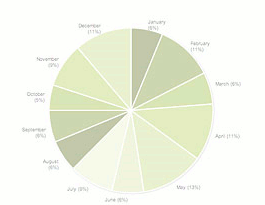


National Academy of Sciences Picks Few Women Again
Hi Friends of Women in Science,
I recently heard from Janet Bandows Koster, Executive Director at AWIS, that only 9 women were elected to the National Academy of Sciences out of 72 new members this year. As you know, we've discussed both the low percentage of women and the lack of transparency by NAS, not addressing their proportions and making anyone interested do all the data analysis herself. It's a real contrast with the Nobel Prize organization, which highlights women who've received it on their site and makes it easy to find the proportions of women.
I want to include a graph that Janet told me about because it shows that in general women are either underachieving or being under-recognized by the National Academy. These data are from the AWIS website here. It shows actual versus expected men elected and women elected over time, so you can see the deficit for women clearly. If you go to the AWIS site, you can see a graph that won't post properly here that compares the women PhDs in different fields with the women elected to the National Academy in those fields, showing for many fields a far lower percentage is elected to the NAS. 

Hi Mad Hatter,
Yes, if I wasn't paying particular attention to why she might be nervous, if she sounded uncertain I'd probably doubt her data to a degree. And maybe, if I were a voter, would vote for someone else. And that's a shame.
cheers,
Laura
Hi Yvonne,
Yes, it's true that for engineers, a higher percent of women were elected to NAS than were present among PhDs. And it might relate to Masters or Bachelors engineers, but I we don't know. Getting any kind of analysis out of NAS is not really feasible. But notice that there is still a fairly small percent women, although a greater percent than among PhDs. More work to do across the board!
cheers,
Laura
Hi friends of women in science,
I decided to get the names and affiliations of the women elected this year and give them here, in case you know any of them, so you can congratulate them. Here is the list as best I could decipher if they were female by the names:
Akil, Huda; co-director, Molecular and Behavioral Neuroscience Institute, and Gardner Quarton Distinguished University Professor of Neuroscience and Psychiatry, University of Michigan, Ann Arbor
Buckley, Rebecca H.; J. Buren Sidbury Professor of Pediatrics and professor of immunology, Duke University Medical Center, Durham, N.C.
Dosher, Barbara A.; dean, School of Social Science, and professor, department of cognitive science, University of California, Irvine
Fowler, Catherine S.; professor emerita, department of anthropology, University of Nevada, Reno
Maquat, Lynne E.; J. Lowell Orbison Chair and professor of biochemistry and biophysics, department of biochemistry and biophysics, University of Rochester School of Medicine and Dentistry, Rochester, N.Y.
Markman, Ellen M.; Lewis M. Terman Professor of Psychology, department of psychology, Stanford University, Stanford, Calif.
McConnell, Susan K.; Susan B. Ford Professor, department of biology, Stanford University, Stanford, Calif.
McLanahan, Sara S.; William S. Tod Professor of Sociology and Public Affairs, Office of Population Research, Princeton University, Princeton, N.J.
Foreign Assoc:
Buckingham, Margaret; professor and director, department of developmental biology, Pasteur Institute, Paris (United Kingdom/France)
Cheers,
Laura
I went to the AWIS site and saw the whole set of data. Wow, there are pretty big discrepancies for some fields. But Laura, did you notice that for engineering there are proportionately more elected to NAS proportionately than the whole proportion among PhD's? Is that related to the use of more masters than PhDs in engineering, I wonder?
So are you saying you wouldn't vote for her for NAS? I wonder how much these things do stay in the back of people's minds when they vote. If they believe she's insecure about her data, that could make them vote no, whoever they are. Neither me nor you, Laura! But we can still have an opinion because it's the NAS of the USA. Like POTUS, they are NASOTUS.
Mad Hatter
Hi Mad Hatter,
Could be true, for at least some of them. Not true of others. The two I'm writing the double biography of don't seem to have confidence issues, or don't show it (Joan Steitz and Jennifer Doudna).
But I saw a prominent woman in science give a talk at the Amer Soc Microbiology today and she looked quite nervous and slightly discombobulated. The science was good, though. So: good or bad for her to talk? She didn't look confident and yet what she had to say made us all take down things in our little notebooks. I'm worried that people will think about her insecure body language when they next consider inviting a woman speaker, though. I so wish she had talked with both confidence and great science.
cheers,
Laura
Hi Laura,
Trying on my devil's advocate hat, I would suggest it's possible that the women themselves don't think they're NAS material due to years of under-appreciation? Nothing convinces as much as confidence, and that's the quality I think women in science need to boost the most.
Mad Hatter
Hi Christi,
I love/hate it. I do wish the NAS wouldn't go all huffy when people like me call up and want to get their current percentage of women as members. They should be more straightforward about it, which makes me think they have something to hide, something to keep undercover. I suspect the selection process may include that kind of subconscious male=scientist bias that comes up in your book, the kind detected by the test online through Harvard.
Cheers,
Laura
Laura,
I love this chart. I'm so glad that AWIS put it together and that you re-posted it. It makes clear that the underrepresentation of women in science - especially at the very top levels - is still a real issue that can't be explained by the numbers of women in the pipeline.
Christi
Hi Melissa,
I know what you mean. I've had men tell me this issue is passe, with a straight face. No more problem, you're just digging up old dirt. It's too bad because that attitude makes it just that much harder to address the issue effectively.
cheers,
Laura
I don't think we can tell, really. The plot showing that the match with percent women was much better in 2003 to 2005 than it is today reflects the lack of emphasis such issues get from top men of science today, in my experience. Discouraging. And their lack of featuring of this issue just shows how unimportant they think this issue is. MKS

















